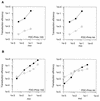Entry of amphotropic and 10A1 pseudotyped murine retroviruses is restricted in hematopoietic stem cell lines
- PMID: 9445044
- PMCID: PMC124622
- DOI: 10.1128/JVI.72.2.1424-1430.1998
Entry of amphotropic and 10A1 pseudotyped murine retroviruses is restricted in hematopoietic stem cell lines
Abstract
Although transduction with amphotropic murine leukemia virus (MLV) vectors has been optimized successfully for hematopoietic differentiated progenitors, gene transfer to early hematopoietic cells (stem cells) is still highly restricted. A similar restriction to gene transfer was observed in the mouse stem cell line FDC-Pmix compared with transfer in the more mature myeloid precursor cell line FDC-P1 and the human erythroleukemia cell line K562. Gene transfer was not improved when the vector was pseudotyped with gp70SU of the 10A1 strain of MLV, which uses the receptor of the gibbon ape leukemia virus (Pit1), in addition to the amphotropic receptor (Pit2). Although 10A1 and amphotropic gp70SU bound to FDC-P1, K562, and fibroblasts, no binding to FDC-Pmix cells was detected. This indicates that FDC-Pmix cells lack functional Pit2 and Pit1 receptors. Pseudotyping with the vesicular stomatitis virus G protein improved transduction efficiency in FDC-Pmix stem cells by 2 orders of magnitude, to fibroblast levels, confirming a block to retroviral infection at the receptor level.
Figures






Similar articles
-
Lack of functional Pit-1 and Pit-2 expression on hematopoietic stem cell lines.Acta Haematol. 1998;99(3):148-55. doi: 10.1159/000040829. Acta Haematol. 1998. PMID: 9587396
-
Superior transduction of mouse hematopoietic stem cells with 10A1 and VSV-G pseudotyped retrovirus vectors.Mol Ther. 2000 Apr;1(4):330-8. doi: 10.1006/mthe.2000.0052. Mol Ther. 2000. PMID: 10933951
-
Gene transfer into marrow repopulating cells: comparison between amphotropic and gibbon ape leukemia virus pseudotyped retroviral vectors in a competitive repopulation assay in baboons.Blood. 1997 Dec 1;90(11):4638-45. Blood. 1997. PMID: 9373277
-
Amphotropic and VSV-G-pseudotyped retroviral vectors transduce human hematopoietic progenitor cells with similar efficiency.Bone Marrow Transplant. 2000 May;25 Suppl 2:S75-9. doi: 10.1038/sj.bmt.1702360. Bone Marrow Transplant. 2000. PMID: 10933195
-
MLV-10A1 retrovirus pseudotype efficiently transduces primary human CD4+ T lymphocytes.J Gene Med. 2000 Nov-Dec;2(6):409-15. doi: 10.1002/1521-2254(200011/12)2:6<409::AID-JGM144>3.0.CO;2-K. J Gene Med. 2000. PMID: 11199261
Cited by
-
Sodium-dependent myo-inositol transporter 1 is a cellular receptor for Mus cervicolor M813 murine leukemia virus.J Virol. 2003 May;77(10):5926-32. doi: 10.1128/jvi.77.10.5926-5932.2003. J Virol. 2003. PMID: 12719585 Free PMC article.
-
Retroviral vectors pseudotyped with lymphocytic choriomeningitis virus.J Virol. 1999 Jul;73(7):6114-6. doi: 10.1128/JVI.73.7.6114-6116.1999. J Virol. 1999. PMID: 10364368 Free PMC article.
-
Simultaneous infection with retroviruses pseudotyped with different envelope proteins bypasses viral receptor interference associated with colocalization of gp70 and target cells on fibronectin CH-296.J Virol. 1999 May;73(5):3960-7. doi: 10.1128/JVI.73.5.3960-3967.1999. J Virol. 1999. PMID: 10196291 Free PMC article.
-
Transduction efficiency of MLV but not of HIV-1 vectors is pseudotype dependent on human primary T lymphocytes.J Mol Med (Berl). 2003 Dec;81(12):801-10. doi: 10.1007/s00109-003-0491-2. Epub 2003 Oct 24. J Mol Med (Berl). 2003. PMID: 14576928
-
The Impact of the Cellular Origin in Acute Myeloid Leukemia: Learning From Mouse Models.Hemasphere. 2019 Jan 30;3(1):e152. doi: 10.1097/HS9.0000000000000152. eCollection 2019 Feb. Hemasphere. 2019. PMID: 31723801 Free PMC article. Review.
References
-
- Agrawal Y P, Agrawal R S, Sinclair A M, Young D, Maruyama M, Levine F, Ho A D. Cell-cycle kinetics and VSV-G pseudotyped retroviral-mediated gene transfer in blood-derived CD34+ cells. Exp Hematol. 1996;24:738–747. - PubMed
-
- Baum, C., C. Stocking, T. Wagener, H.-G. Eckert, and W. Ostertag. Gene transfer and transgene expression in hematopoietic cells. In M. Strauss and W. Barranger (ed.), Concepts of gene therapy, in press. Walter de Gruyter, Berlin, Germany.
-
- Beck-Engeser G, Stocking C, Just U, Albritton L, Dexter M, Spooncer E, Ostertag W. Retroviral vectors related to the myeloproliferative sarcoma virus allow efficient expression in hematopoietic stem and precursor cell lines, but retroviral infection is reduced in more primitive cells. Hum Gene Ther. 1991;2:61–70. - PubMed
Publication types
MeSH terms
LinkOut - more resources
Full Text Sources
Other Literature Sources
Medical
Research Materials
Miscellaneous

